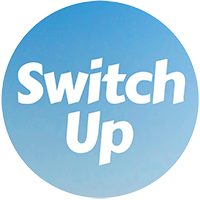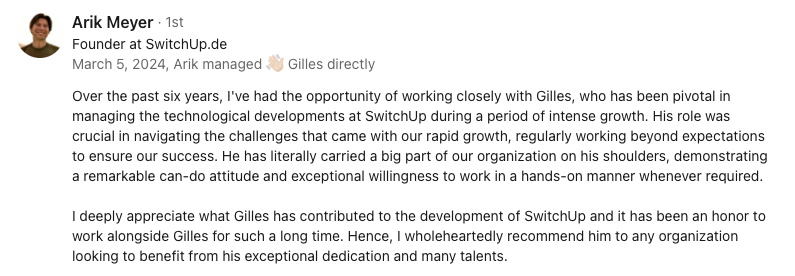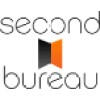Abstract:
The article emphasizes the importance of personal branding for tech leaders in Europe, highlighting it as a vital tool for building trust, credibility, and effective leadership. The author, drawing from personal experiences across cultures like Beijing and Berlin, underscores that personal branding is not about mere visibility but aligning one's identity with core values and goals. For tech leaders, authenticity is crucial, as it enhances trust and leadership impact. The article explores how personal branding aids in work-life balance by setting boundaries and aligning personal values with professional goals, which boosts job satisfaction and resilience. Real-world examples, such as Nicolas Brusson of BlaBlaCar and Taavet Hinrikus of Wise, illustrate how personal branding can enhance transparency, sustainability, and customer focus, fostering innovative and supportive work environments. The piece also discusses strategies like consistent messaging and content creation for maintaining a strong personal brand, using tools like LinkedIn and Canva. Future trends, such as hybrid work models, are reshaping personal branding, emphasizing adaptability and authenticity. Ultimately, personal branding is portrayed as a journey of authenticity and strategic alignment, crucial for tech leaders to build connections and foster a fulfilling career.
Personal branding is crucial for tech leaders in Europe's busy tech scene. It's more than just making a name for yourself—it's about creating an identity that matches your values and goals. This isn't just about appearances; it's about building trust and credibility, which are essential for leadership. With a career spanning cultures, from Beijing to Berlin, I've seen how a genuine personal brand can connect different cultures, fostering trust and connections. Let's explore how tech leaders can leverage personal branding to enhance their careers and make their leadership impactful and authentic.
The Essence of Personal Branding for Tech Leaders
In Europe's tech world, personal branding is key to success. From my experiences in Beijing and Berlin, I've learned that personal branding is about being genuine and showing your true professional self. For tech leaders, it's not just about standing out; it's about earning trust, which is crucial for leading effectively.
Building Trust Through Personal Branding
Creating a personal brand means showing who you really are and what you aim for. For tech leaders, it builds trust and credibility. Authenticity is crucial here. A study in the Journal of Business Ethics found that being genuine boosts trust. During my time working in different cultures, I once led a team in Berlin where I openly shared my values and vision. This transparency not only built trust but also encouraged team members to align with our collective goals. A strong personal brand helps you stand out and connect in the tech world.
Standing Out with Strategic Personal Branding
In tech, personal branding differentiates you. It highlights what makes you unique and helps you advance in your career. A well-thought-out personal brand aligns with the values important for tech leadership. The Edelman Trust Barometer shows that thought leadership and strategic branding can enhance a leader’s image. Aligning your personal brand with your vision promotes authenticity, fostering career growth and establishing you as a trusted leader.
Aligning Authenticity and Leadership
For tech leaders, personal branding is about more than standing out; it’s about being true to yourself and demonstrating leadership and adaptability. Authenticity builds trust and credibility, while thought leadership showcases expertise and forward-thinking. The European Commission's Digital Economy and Society Index highlights the need for innovation, making adaptability crucial for personal branding. For leaders who understand different cultures, aligning personal and professional values is key. This alignment not only enhances authenticity but also supports adaptability, critical in tech's ever-changing landscape.
Personal Branding as a Boundary-Setting Tool
To achieve work-life balance, personal branding is a powerful tool for setting boundaries between work and personal life. Tech leaders can use this to balance these aspects, leading to a more fulfilling life, especially amidst the flexible work arrangements common in European startups.
Balancing Life Through Branding
Personal branding helps set clear boundaries, crucial for work-life balance. By defining these boundaries, tech leaders can manage their time and energy better, meeting both personal and professional needs without conflict. According to the Journal of Organizational Behavior, setting boundaries through personal branding enhances flexibility and prevents burnout, important for long-term success.
Real-World Applications of Boundary Setting
Real-life examples show how tech leaders use personal branding to set boundaries. For instance, leaders who communicate their values clearly can better define what's important personally and professionally. The Journal of Business and Psychology explains how these practices create a more controlled work environment, helping with the transition between work and personal life. Consider these strategies:
- Consistent Messaging: Maintain clear personal and professional boundaries across platforms.
- Open Dialogue: Engage in open discussions with team members to express boundaries and expectations.
- Document Boundaries: Outline boundaries in documents and share with stakeholders.
- Digital Limitations: Set specific times for work-related communications.
- Flexibility and Adaptability: Be open to adjusting boundaries as personal and professional needs evolve.
By using these strategies, tech leaders can effectively communicate their boundaries, ensuring their personal brand supports a balanced work-life approach.
Aligning Personal Values and Professional Goals
In tech, balancing personal values with professional goals is crucial for leaders. This alignment boosts job satisfaction, builds resilience, and guides decision-making, leading to a career that harmonizes personal beliefs with work goals.
The Importance of Value Alignment
Aligning personal values with professional goals affects job satisfaction and ethical leadership. When tech leaders incorporate their core values into their work, they feel more fulfilled and act with integrity. This alignment ensures ethical decision-making and builds trust with colleagues and clients. The Journal of Business Ethics notes that when executives work in value-aligned environments, they handle pressure better, making ethical leadership sustainable.
Resilience and Stress Management
Value alignment strengthens resilience. In high-pressure tech environments, a strong foundation of personal values helps leaders handle stress and avoid burnout. The American Psychological Association states that aligning personal and professional values helps manage stress, providing a buffer against tech world challenges.
Real-World Examples of Value Alignment
Successful tech leaders show the benefits of aligning their brands with core values. Leaders who prioritize transparency and ethics in branding report better performance and more cohesive teams. For example, those guided by sustainability often find decisions aligning with their ethics, leading to innovation and consistency. This alignment guides leaders through complex business landscapes, ensuring effective and respected leadership.
Decision-Making and Prioritization
Aligning one's personal brand with core values shapes decision-making and task prioritization. By creating a framework for consistent, ethical decisions, tech leaders navigate their roles with clarity and confidence.
Guiding Ethical Decision-Making
A strong personal brand guides ethical decision-making. When leaders align their values with their roles, they ensure ethical considerations are always prioritized. This builds trust and credibility within teams. Considerations include:
- Clarity: Define core values that resonate personally and professionally.
- Consistency: Ensure decisions reflect these values consistently.
- Communication: Articulate values clearly within the organization.
Task Prioritization Through Branding
Personal branding offers a clear approach to prioritizing tasks, helping tech leaders focus on initiatives aligned with personal and organizational values. This boosts efficiency and ensures resources go toward projects that match the team's core mission. The Academy of Management highlights how leaders who prioritize through personal branding foster innovation and engagement, inspiring their teams.
Value-Driven Leadership's Impact
Value-driven leadership affects team engagement and culture. Leaders with strong personal values set a precedent that resonates throughout the organization. The Journal of Business Ethics suggests that leaders who prioritize value-driven initiatives positively influence organizational culture, promoting integrity and collaboration.
Leveraging Personal Branding for Mental Well-Being
In tech's demanding world, personal branding isn't just for career advancement; it's crucial for mental well-being. By establishing a coherent, authentic brand, tech leaders gain self-awareness and stress management, boosting mental health.
Psychological Benefits of Personal Branding
A strong personal brand isn't just for standing out; it offers psychological benefits. It increases self-awareness by clarifying values and strengths. This clarity boosts confidence, creating a positive feedback loop. According to the Journal of Business and Psychology, those with a clear personal brand feel more confident, affecting all life aspects.
Personal branding also provides clarity, reducing stress. When leaders align their brand with values, they gain focus, reducing decision-making stress. The Institute of Leadership & Management notes that this clarity shields against burnout by helping prioritize meaningful tasks.
Resilience is supported by personal branding. Affirming what they stand for, tech leaders build a mental framework for their journey. The Gallup Organization points out that a well-articulated brand reinforces purpose, crucial for long-term success and well-being.
Strategies for Using Personal Branding to Manage Stress
Tech leaders can use personal branding strategies to manage stress effectively. Branding guides setting boundaries and managing expectations, essential for balance. Here are techniques:
- Define Boundaries: Use your brand to mark where work ends and personal life begins.
- Manage Expectations: Communicate your values and priorities clearly.
- Prioritize Tasks: Focus on initiatives aligned with your brand, reducing unnecessary workload.
Building a support network and continuous learning are key for mental well-being. The American Psychological Association emphasizes having support for emotional backing and advice during challenges. Continuous learning keeps leaders adaptable and resilient.
Effective communication helps manage stress and maintains clarity. By clearly conveying your stance on issues, misunderstandings are reduced. The Harvard Business Review suggests that open communication ensures everyone aligns with the brand's mission and values, reducing stress and strengthening workplace relationships.
These strategies help tech leaders enhance their personal brand while nurturing mental well-being, balancing professional success with personal fulfillment.
Practical Steps for Developing and Maintaining a Personal Brand
Building a strong personal brand is vital for tech leaders in today's competitive field. It requires a clear strategy and consistent effort.
Building a Personal Brand
Defining a unique value proposition is the first step in creating a memorable brand. Marketing strategist Dorie Clark says it's essential to pinpoint strengths and what sets you apart. This serves as the foundation of your brand strategy. Branding expert William Arruda emphasizes consistent online presence. Using the same photo, name, and messaging across platforms like LinkedIn ensures coherence and reinforces identity. Then, focus on content creation and networking.
Enhancing Visibility Through Content and Networking
Content creation and networking boost your brand's visibility. Regularly sharing insightful content positions you as a thought leader. A LinkedIn survey revealed consistent content posters are ten times more likely to be approached for opportunities. Networking, both online and offline, builds relationships and expands reach. These practices cultivate a brand that stands out. A brand audit and feedback refine perception.
Refining Your Brand Through Audits and Feedback
Regularly auditing your brand ensures relevance and impact. This involves evaluating how others view your brand and finding areas for improvement. Feedback is key. According to the Journal of Business Research, insights from peers and mentors provide valuable perspectives. Key steps in a brand audit include:
- Set Google Alerts for online mentions.
- Use platforms like BrandYourself to assess your digital footprint.
- Gather feedback from colleagues and peers.
After refining through audits and feedback, explore tools and technologies for ongoing brand management.
Tools and Technologies for Personal Brand Management
Using the right tools and technologies is crucial for managing a personal brand, helping tech leaders maintain brand integrity and visibility across platforms.
Social Media for Networking and Thought Leadership
Social media like LinkedIn and Twitter are essential for personal brand management. They provide networking opportunities, industry insights, and thought leadership. LinkedIn is a professional hub, while Twitter offers real-time engagement. These platforms help tech leaders connect with their audience and strengthen their presence.
Crafting Narratives with Content Creation Tools
Tools like Canva and Medium are key for creating and managing personal narratives. Canva helps produce visually appealing content, while Medium offers a platform for in-depth articles. These tools allow control over your brand's narrative, ensuring alignment with values and goals.
Enhancing Brand Presence with Reputation Management
Reputation management tools and analytics maintain a strong personal brand. Tools like BrandYourself monitor and manage your online reputation. Analytics tools like Google Alerts keep you informed about brand mentions. Staying aware of your brand's presence helps refine strategy and address issues.
Real-World Examples of Successful Personal Branding in Tech
Nicolas Brusson: Transparency and Sustainability
Nicolas Brusson, co-founder and CEO of BlaBlaCar, exemplifies using personal branding for transparency and sustainability in tech. His brand ties closely to these values, deeply integrated into BlaBlaCar's mission of efficient, eco-friendly travel. Through open communication and sustainable practices, Brusson's brand builds trust and accountability, attracting like-minded employees and users.
Taavet Hinrikus: Innovation and Customer Focus
Taavet Hinrikus, co-founder of Wise, uses personal branding to advocate for innovation and customer focus. His brand emphasizes simplicity in financial transactions, challenging traditional banking. By promoting openness and efficiency, Hinrikus positions Wise as a fintech leader. His commitment to customer-centric solutions reflects in Wise's seamless services, earning a loyal customer base.
Branding's Impact on Productivity and Well-Being
Brusson and Hinrikus show personal branding's impact on productivity and well-being. Aligning personal values with corporate missions creates innovative, supportive work environments. The Journal of Organizational Behavior notes this alignment boosts job satisfaction and reduces stress, enhancing productivity.
Future Paths in Personal Branding for Tech Executives
New Horizons in Personal Branding
New trends like hybrid work models and digital footprints reshape personal branding. With many working efficiently from home, resilience and adaptability are key. LinkedIn's 50% rise in content creation shows the importance of maintaining a strong online presence. This requires a dynamic approach blending digital engagement with modern work flexibility.
Reimagining Work-Life Balance
These trends change strategies for work-life balance among tech leaders. Hybrid models make personal branding a bridge between work demands and personal needs, supporting balance. The Edelman Trust Barometer shows growing expectations for authenticity. Leaders should craft personal brands aligning with company values, promoting flexibility and balance.
Influence on Cultural and Leadership Styles
Personal branding can transform company culture and leadership styles. Brands prioritizing transparency, innovation, and ethics change organizational climates, fostering openness and engagement. The Journal of Business Research highlights how executive brands influence organizations, instilling values that promote ethical leadership and supportive cultures.
Embracing personal branding in tech is a journey of authenticity and strategic alignment. It's about building trust and credibility that connects across cultures and industries. Personal branding is a powerful tool for tech leaders, enhancing leadership and work-life balance. Aligning your brand with core values builds resilience and fosters connections, transforming your professional path into a fulfilling career.
You might be interested by these articles:
- Merging Work and Life in the Digital Age
- Navigating Work-Life Integration
- Navigating EU Regulations: A Tech Executive’s Guide to Balancing Compliance and Work-Life Harmony





